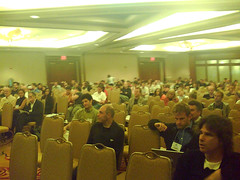Washington, D.C.
We're in the last session for today already, and Stefan Schutt makes a start. He's in the process of building Small Histories, a Website for users to upload and compare their life stories. Stefan begins by sharing his own very interesting life story (his family originates from Pomerania, and is now spread across the world including relatives in Germany, France, and Israel). Inspired by such family history, Stefan has built a Website for uploading and sharing this and similar stories; this enables users to compare perspectives on events and times in history through sharing their own small histories, putting them out into the public domain without the need for turning them into something else first.
The site becomes a self-generating archive of personal stories, creating a network of nodes and pathways; narratives become the paths we take through the stories within the network, which remains dynamic. Moving through these content items is to experience one version of a story, and the links between individual items therefore become crucially instrumental. The collection of content remains malleable, however, enabling users to trace their own stories through these materials - an example of the new, collaborative, database-driven social software paradigm of the Web in its emerging 2.0 form. As a special feature, the site requires users to include at least one link to a piece of content uploaded by another user, thereby enabling the cross-connection of materials and the development of user-determined pathways across multiple contributors' stories. This also raises a number of questions, of course, including authorial control and the forms of moderation which may be necessary for the site, trust in the veracity of information and the good will of participants, and access to the shared resource.
 I'm the second presenter, and my paper "Produsage: Towards a Broader Framework for User-Led Content Creation" is online here on the blog; I've also uploaded the Powerpoint, and
I'm the second presenter, and my paper "Produsage: Towards a Broader Framework for User-Led Content Creation" is online here on the blog; I've also uploaded the Powerpoint, and I'll try upload a recording of the presentation soon a recording of my presentation is below as well as here.
Piero Mussio is the next speaker, presenting on behalf of a wider group of co-authors. He presents the Tarchna project, which aims to make Etruscan heritage accessible and understandable to a wider public (as well as producing sufficient funds to keep the project going). Cultural heritage information is held across all over Europe, and the project therefore tries to create a federated IT structure to enable archaeologists. Information scientists working on the project have suggested an ontological structure to describe available information and thereby pull it together, but unfortunately archaeologists and computer scientists operate in vastly different paradigms: the model-based and algorithmic model of IT specialists clashes with the analogy-based and heuristic model of archaeology. Archaeology also used a variety of different terms and meanings, where the IT ontology relied on a systematic and unambiguous system; this ontology therefore acted as a golden cage for the archaeologists working on the project.
The solution to such problems lies in the admission of a symmetry of ignorance in both groups, and the implementation of a progressive sematization process taking the initial ontology as a point of departure and developing incremental prototypes used to externalise stakeholders tacit knowledge. A first result of this was the development of a non-canonical mind map collecting and organising archaeologists' understanding of the Etruscan culture; this was further developed and placed alongside the initial ontology as a related and equivalent model for organising knowledge. Ultimately, this led to the emergence of an evolving concept of narration, through which the Tarchna Engine interprets contexts of user interaction with available data and provides further related information. Archaeologists change from authors of text and context to be presented to visitors to authors of text and context descriptions, but can no longer predict the full range of information which will be presented to their users. In this way, tools, users, technologies and organisations co-evolve in their engagement with information and knowledge, and the system becomes a creative unit in its own right.
The final speaker is Andruid Kerne, speaking on behalf of a larger group of researchers examining information discovery tasks (tasks in which participants' goal is to have an idea: creative information). Much of this work takes creative cognition research as its precursor, which has identified strategies such as convergent and divergent thinking. Convergent thinking assumes that there is one final answer to be arrived at, while divergent thinking allows for open questions with many correct answers. Information discovery tasks are divergent thinking tasks in which people identify, and organise information in order to synthesise and develop new ideas, then.
Andruid highlights the idea of composition and combinFormation as a means of developing information and text surrogates which represent information resources and allows the user to access them; this represents information collections as a whole, rather than lists of the information contained within them. Such ideas were applied to the development of advanced undergraduate-level psychology information resources, and student work was scored on the basis of the degree of emergence of new ideas, and the quality of such ideas. Overall, in comparison with conventional text-based information presentation and student assessment models, this new model performed considerably better across a variety of criteria.












